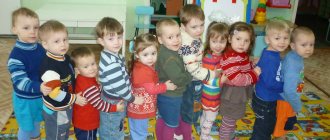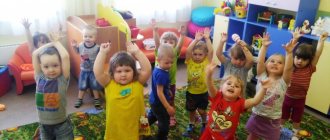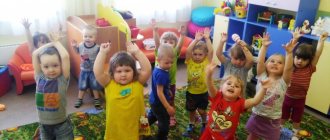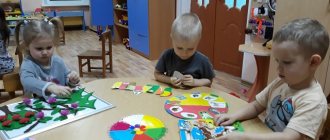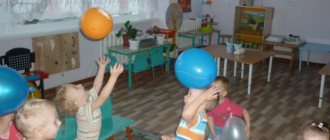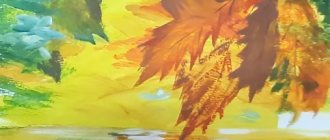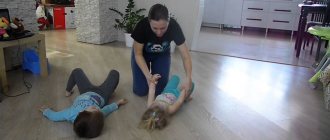- didactic games;
- orientation-cognitive work;
- study of illustrations;
- subject activity;
- motor games;
- self-service;
- observations of surrounding phenomena;
- visual activity;
- execution of practical instructions from the elder.
Compliance with the conditions allows the teacher to properly organize children’s independent time:
- Allocating the optimal amount of time for classes.
- Creating space for activity and an atmosphere for other activities.
- Sorting material suitable for different types of activities of preschoolers.
- Choosing the location of play equipment in a group room.
- Personal communication between the teacher and the child is effective, for whom a method of influence is chosen that is more appropriate to the developmental characteristics of the preschooler.
- Organization of management of all types of children's activities.
One of the important tasks for a teacher in organizing children’s independent work is maintaining a calm, balanced state of the child.
For a successful story game, students will need special paraphernalia that allows them to better reflect their experiences and impressions.
Educational games for children of the second junior group card index (junior group)
ABOUT
Educational games for children 3-4 years old in kindergarten. Card index
Games for developing thinking for preschoolers 3-4 years old
Game "Who sleeps where."
Goals: to develop mental abilities, ideas about basic geometric shapes; assign a color name; form selection actions according to the model.
Game material and visual aids: cards divided into sectors (each sector contains a geometric figure).
Description: children remember the names of familiar human figures. The teacher distributes cards showing “beds” for each of the figures. The “little people” must be put to “sleep” in beds suitable for them, that is, all the figures must be laid out on cards so that they coincide with those drawn. For example: a person who has the shape of a square lies down in a crib of the corresponding shape.
Game "Endless classification".
Goal: to develop classification skills, attention, memory.
Game material and visual aids: cards with images of animals and some other objects.
Description: lay out all the cards. Invite your child to separate all the cards with images of animals. Next, animals are divided into wild and domestic. From the domestic ones, in turn, select those who have hooves and sort them into those with horns and those without horns. Animals can be classified according to the following characteristics: fluffy - smooth-haired, predator - herbivore, swims - does not swim, jumps - does not jump, etc.
Game “In the garden, in the vegetable garden...”.
Goals: develop classification skills; help explore the order of things.
Game material and visual aids: cards with images of a vegetable garden, garden, forest; figures of vegetables, fruits, berries, mushrooms (cut out of cardboard).
Description: invite the child to correctly distribute the cut out figures, remembering what grows where: vegetables - in the garden, berries and mushrooms - in the forest, fruits - in the garden.
Game “What should we put in the refrigerator?”
Goals: develop classification skills; help explore the order of things.
Game material and visual aids: cards with images of a refrigerator, wardrobe, china cabinet, bookcase, images of objects stored in the refrigerator, wardrobe, etc.
Description: tell your child a story about how one boy decided to indulge himself: he took out all the food from the refrigerator, clothes from the closet, as well as all the dishes and books. All the things were mixed up, and he could not put them back in place, but the boy’s mother would see and be upset. “Let’s help the child and put everything in its place: food next to the refrigerator, clothes near the wardrobe, books near the bookcase, dishes in front of the cupboard.”
Game "Find the picture".
Goal: to develop memory and attention.
Game material and visual aids: pictures of the same format with different images.
Description: show the child a picture. He must examine it carefully. Invite the child to turn away and lay out all the pictures, including the one previously discussed. Offer to find a picture that he has already seen.
Game "Guess the picture."
Goal: to develop attention, auditory perception, speech.
Description: Post several pictures with different images. For the first lessons, you should choose a drawing with a single subject. Invite the child to choose a picture, but do not say which one. Ask your child questions, the answers to which will lead to a solution. For example: “Does the picture you chose show an animal? Is this a wild or domestic animal? Is it with horns? With hooves? He has a long tail? Etc.". Offer to switch roles: the teacher makes a picture, and the child asks questions.
Game "What am I doing?"
Goal: to develop attention and imagination.
Description: invite the child to play an interesting game: the teacher imitates certain actions, and the child must guess what this means. For example: the teacher folds his fingers as if holding a pencil and moves his hand along an imaginary paper. The child must guess what the teacher is “drawing” or “writing.” You should show simple, understandable gestures (knock with a hammer, eat with a spoon, drink from a cup, throw a ball, etc.). Then switch roles.
Game "Who does it."
Goal: to develop speech, observation, logical thinking.
Description: invite the child to guess who the story is about. List the actions of this or that person. For example: comes home from work, has dinner, plays with you, goes with us to the park, circus, etc. (Mom or Dad.) Cuts hair, does hairstyles, works in a hairdresser. (Hairdresser.) Treats children and adults, wears a white coat, listens with a phonendoscope. (Doctor.)
Game "Who's Got It"?
Goal: to develop speech, attention, memory, observation.
Description: see the game “Who Does It” (objects that evoke associations with human actions are listed). Explain the rules to the child and start listing. For example: who has round brown glasses, a green jacket and a gift for you? (At Grandma's.) Who has a white coat, a phonendoscope, a white cap? (At the doctor.) Etc.
Game “The cow gives...”.
Goal: to develop attention and memory.
Game material and visual aids: cards with images of animals, products obtained from animals (milk, eggs, wool, etc.).
Description: Arrange the cards in random order. Invite the child, next to the image of each animal, to put an image of what this animal gives us. For example: chicken - egg, feathers (you can draw a pillow); cow - milk (cottage cheese, sour cream, kefir); goat - downy yarn (draw socks, mittens), etc.
Game "Narrow - Wide".
Objectives: to introduce the concepts of “narrow - wide”; develop matching skills.
Game material and visual aids: two balls of different sizes.
Description: invite the child to roll balls along a path fenced with cubes. Make two stripes - one for the small ball, the other for the large one. Roll a small ball along a wide path, then try rolling a large ball along a narrow path. Encourage your child to explain why the ball cannot fit on the small track. Introduce the concepts “narrow - wide” into your child’s active vocabulary. Experiment: move toys of different sizes along the paths. At the end of the game, generalize: a wide path is for large toys, a narrow path is for small ones.
Game "Comparison of quantities."
Goal: to develop comparative analysis skills, speech, logical thinking.
Game material and visual aids: wide and narrow strips of paper, cubes.
Description: invite the child to build houses for the mouse and for the bunny: “Do you think we will build them houses of the same size?” Encourage the child to conclude that the mouse’s house should be smaller than the bunny’s house.
After the houses are ready, tell them that the animals asked to put paths in front of their houses for guests. But to prevent guests from getting confused, the path in front of the mouse house should be narrow, and in front of the hare house - wide. Show your child how to determine which of the tracks (paper strips) is wider by placing them on top of each other. Let the child himself distribute the paths between the houses.
Game “How to distinguish them?”
Goal: to develop the skill of comparative analysis of objects by superimposing them on each other.
Game material and visual aids: identical geometric shapes with slight differences in size (cut out of paper).
Description: tell the child that the figures are cakes for dolls. Our scattered dolls mixed up all the cakes and cannot determine which is which. After all, the cake for Masha is larger than the cake for Olya, and the cake for Sveta is the smallest. We need to help the dolls. Let the child think about how this can be done. Show him how, by placing the figures on top of each other, he can figure out which cake is bigger and which is smaller. Give the dolls their dessert.
Game "Pick up a Christmas tree."
Goal: to develop matching skills, the ability to use words “above - below”, speech.
Game material and visual aids: Christmas trees (cut out of paper) of different sizes.
Description: draw a house. Tell your child about the boy who lives in this house. Draw snowdrifts near the house. Explain that New Year is coming soon. This means that you definitely need a Christmas tree: “Help me choose a Christmas tree that will fit in the house.” Place the Christmas trees on another sheet of paper. If the child cannot cope with the task, show him how you can compare the size of a Christmas tree and a house by placing a tree next to it. When placing the Christmas trees, comment: “No, this Christmas tree won’t suit us, it’s taller than the house, it won’t fit there. And this Christmas tree is too small, it’s lower than the house.”
Game “Does this happen?”
Purpose: to help study the category “above - below”.
Description: draw a multi-story house, next to it is a village house of the same size. Ask your child if it is possible for these houses to be the same size in real life? Finding out why this cannot be (many floors - one floor), means that a multi-story house is higher, and a village house is lower.
Game “How are they similar?”
Goal: to develop attention and observation.
Description: show the child two objects, ask him to talk about what these objects have in common, and then how they differ. For example: “Look at a ball and a cube of the same color.” General: both items are toys, both are the same color. Differences: the ball is round, the cube is square, the ball is large, the cube is small. To complicate the game, show the child objects with less pronounced differences, for example: two cars of the same color, but with different wheels, body shape, etc.
Game "Freight Train".
Goal: develop logical thinking.
Game material and visual aids: cards depicting objects of different categories (dishes, furniture, animals).
Description: invite your child to play with the train. Trains go to different cities and carry different goods. For example, a train going to Moscow is carrying dishes. Therefore, the pictures of the trailers should show items of this category. A train going to another city carries wild animals, etc. To complicate the game, lay out cards of different categories, but made of the same material, for example, wooden spoons, wooden chairs, wooden cubes, boards, etc.
Game "Guess what I'm talking about."
Goal: to develop logical thinking, memory, attention.
Description: invite the child to find an object in the room. Describe its location, color, shape, material from which it is made, etc. For example: “What I wished for is now under one of the chairs in this room. This object is small, round, rubber, red.” To complicate the game, in the future do not name the place where the object is located, listing all its other signs.
Game “What Happens...”
Goal: to develop speech, memory, and the skill of generalizing objects by attribute or property.
Description: the teacher asks the child questions, and he answers them. For example: “What is yellow?” (Chicken, sunshine, etc.); “What grows on a tree?”; "Who lives in the forest?" etc.
Game "What is it like?"
Goal: develop comparison skills.
Description: invite your child to play questions and answers. For example: “What is as round as a ball?” (Watermelon, orange, apple, etc.); “What is as white as snow?”; "What's as sweet as sugar?" etc.
Game "Show the path."
Goal: to develop fine motor skills and logical thinking.
Description: draw small images of animals in different places and, at a distance from them, what these animals eat as food. For example, if a hare is drawn on a piece of paper, then there should be a carrot or cabbage, a bear should have a barrel with the inscription “Honey”, a mouse – cheese, etc. Invite the child to draw lines that will show the animal where his favorite food is. You can play in accordance with the themes: “People - clothes”, “Animals - home”, “Tree - leaf”, etc. To complicate the task, draw several trees or flowers in the middle of the leaf, explaining to the child that the path should go around them.
Educator: Gulieva Z.A.
Source: https://yadi.sk/d/WVVdC5d2y3UCpA
